Honda Accord vs. Toyota Camry: Compare Sedans
Believe it or not, cars still account for about 20% of new vehicle sales. The many models of the Toyota Camry still outsell most other popular crossovers except for the Toyota RAV4. The newly redesigned Honda Accord suggests that Honda’s not ceding to crossovers, either. This classic battle between two of the bestselling mainstream sedans in history rages on, even in the electrified era.
The 2023 Honda Accord arrives with a new if not tamer look, and a cleaner hybrid option expected to account for more than half of Accord sales. The bestselling 2023 Toyota Camry makes its mark with three powertrain choices across six trim options, including an all-wheel-drive option lacking in the Accord.
Despite their nuances, they’re more similar than different, with starting prices below $30,000 and crash-minimizing standard safety features. Either one is a solid choice, but for different reasons. Here’s how we rank these sedans, and a side-by-side look at their competitive advantages.
Honda Accord vs. Toyota Camry price, trims, and warranty
Camry ranges from less than $28,000 to nearly $38,000
Accord ranges from above $28,000 to more than $39,000
Best picks: Honda Accord Hybrid EX-L, Toyota Camry XLE
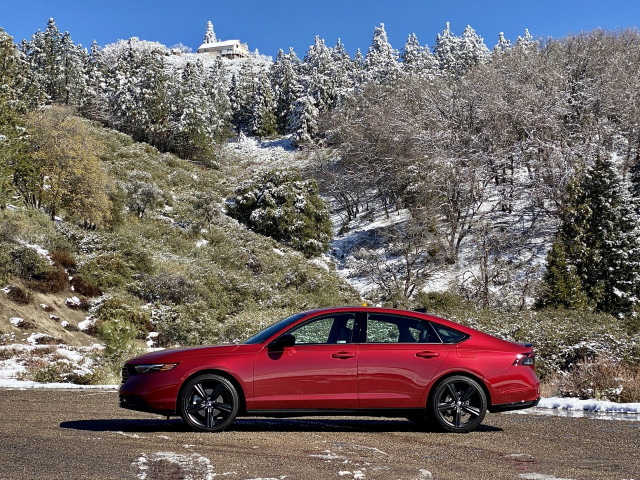
2023 Honda Accord Hybrid
Which Honda Accord should I buy?
Honda prefers you to buy the Accord Hybrid. The base LX and EX with the turbo-4 are cheaper, but the roughly $4,000 upcharge for the Hybrid includes a lot of feature upgrades as well. For about $28,500 including destination, the 2023 Accord LX comes with the basics expected in a new car, such as cloth seats, a 7.0-inch touchscreen with Apple CarPlay and Android Auto compatibility, a 10.2-inch digital instrument cluster, and two USB-C ports.
Stepping up to the base Sport Hybrid for $33,000 adds a 12.3-inch touchscreen with wireless smartphone compatibility and available wireless charging, a sunroof, a power driver seat, dual-zone climate control, and a leather-wrapped steering wheel. For about $1,500 more, we’d look at the EX-L for the Accord Hybrid best buy. It sticks with more efficient 17-inch wheels and tires instead of the 19-inch wheels on other Hybrids and adds leather seats, a power passenger seat, as well as heated front seats and side mirrors.
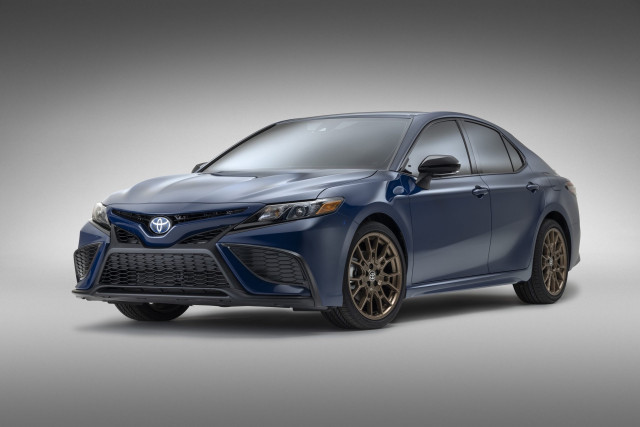
2023 Toyota Camry
Which Toyota Camry should I buy?
With six trims and three engine choices, the Camry proposition is less clear-cut: It comes down to which powertrain you prefer. Base LE, SE, and SE Nightshade models can be had with the 2.5-liter inline-4 or the Hybrid, but pricier XLE and XSE grades can be had with a V-6. The $34,500 TRD model only comes with the V-6. The $1,400 all-wheel-drive option is only available with the 2.5-liter.
At $27,500, the base Camry LE costs $1,000 less than the base Accord and comes with similar features, such as a 7.0-inch touchscreen with smartphone compatibility. But the infotainment interface feels a generation behind the new Accord’s. Toyota’s Hybrid upgrade is only about $2,200 across the lineup, but doesn’t include the same feature upgrades as the Accord. We like the Camry XLE for $32,000, or $34,500 for the Hybrid. It has wood inlaid trim, power leather front seats that are heated, a wireless smartphone charger, a 9.0-inch touchscreen, and options such as a heated steering wheel. That’s not an option on any Accord.
Which car has the better warranty?
Honda Accord and Toyota Camry warranties are nearly identical, with a three-year/36,000-mile basic warranty, and the first two years or 24,000 miles (Accord; Camry goes to 25,000 miles) of scheduled maintenance are included. But the Camry Hybrid gets the edge, because Toyota covers the battery for 10 years or 150,000 miles, versus Honda’s eight-year/100,000-mile warranty for battery components.
Advantage: Draw; the Camry has more options, the Accord Hybrid is better equipped.
![2023 Honda Accord Hybrid 2023 Honda Accord Hybrid]()
2023 Honda Accord Hybrid
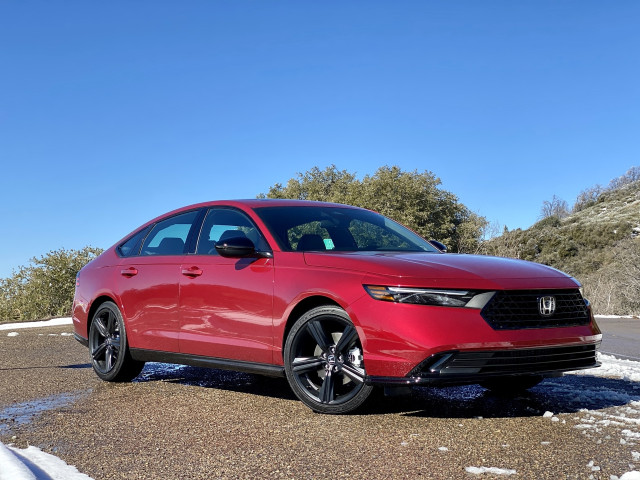
2023 Honda Accord Hybrid
Accord vs. Camry interior and exterior design
The Camry offers more personalities
The Accord wins on the interior
Camry TRD turns up the sport
Is the Honda Accord a good-looking car?
It is, though not as striking as it was a generation ago, when its fastback profile had a clear advantage over the Camry. Honda softened the latest design to something more conservative; it went from looking like an Audi to looking like a VW Passat. Growing 2.7 inches in length, the Accord goes for a long and low look, with a hood dipping down over a broad two-piece grille.
Inside, it adopts the Civic’s mesh vent panel and clean dashboard. Honda ditched nicer elements such as fake wood trim and gear buttons for a mechanical shifter, but the low dash better integrates the available 12.3-inch touchscreen. A panel of dials and buttons for audio and climate reduce reliance on the touchscreen for everyday functions, and overall it’s a clean, uncluttered cabin.
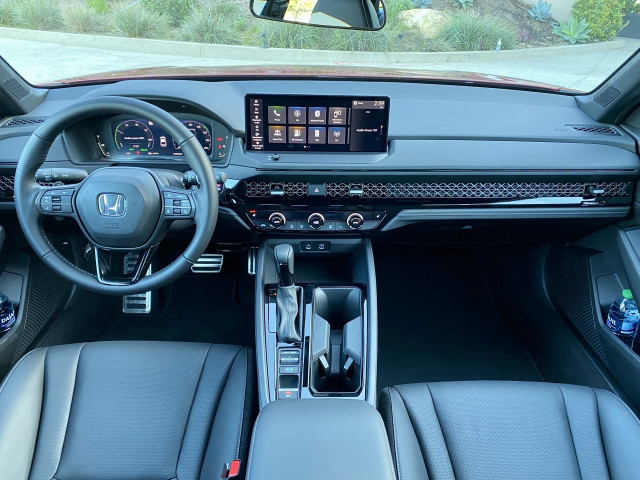
2023 Honda Accord Hybrid
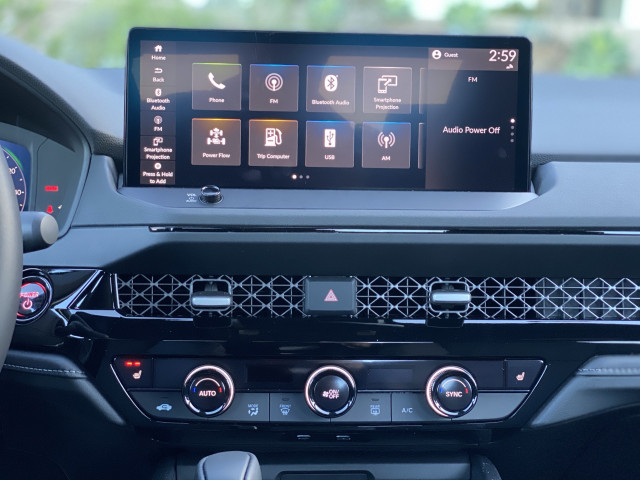
2023 Honda Accord Hybrid
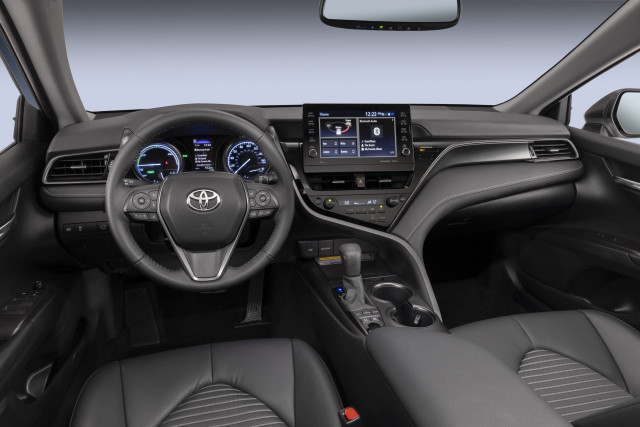
2023 Toyota Camry
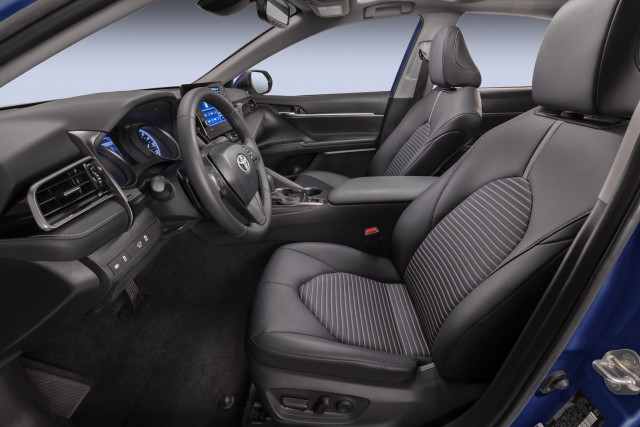
2023 Toyota Camry
Is the Toyota Camry a good-looking car?
Unlike the Accord, the Camry wants to stand out, and nearly tries too hard in doing so. With its long nose and short trunk, it pretends to be a rear-wheel-drive grand tourer. Up front, Toyota carves out folds and creases as if it were a Star Wars fighter. Each trim has a distinct personality, with the Nightshade edition flashing 19-inch bronze wheels and black trim garnishes, while XSE grades sport rocker panels and black wheels. TRD models flex matte black wheels, a black rear spoiler, a front splitter, and dual exhaust tips.
Toyota tames down the Camry inside into a hodgepodge of influences. The dash cascades into the console, creating a short knee wall beside the passenger. Flimsy Radio Shack buttons flanking the outdated infotainment screen and waves of dash plastic belong to another era.
Advantage: The Accord for its interior.
Camry vs. Accord performance
This is where the sedans most deviate. Honda leans into the Accord Hybrid, but the base model’s small turbo-4 strives more for efficiency than anything else. Toyota offers three powertrains in the Camry, including a relatively large 2.5-liter inline-4 and a V-6 that’s practically endangered in the mainstream sedan segment. The Camry’s other advantage over the Accord is the option of all-wheel drive with the inline-4.
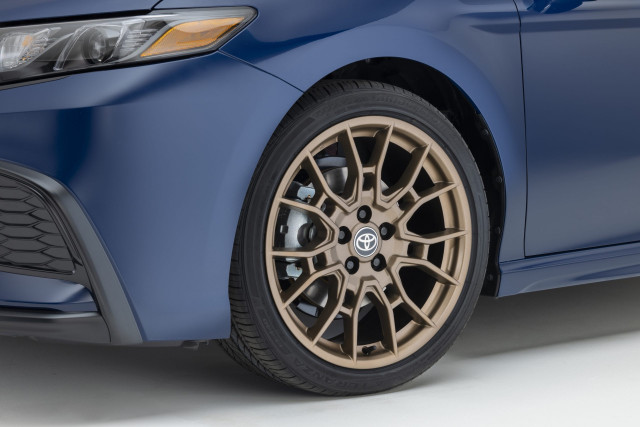
How does the Toyota Camry drive?
203-hp 2.5-liter inline-4 with an 8-speed automatic transmission
301-hp 3.5-liter V-6 in front-wheel drive only
208-hp Hybrid with a 2.5-liter inline-4 and an eCVT
As a reasonable commuter car without any fanfare, the base inline-4 does the job fine. The 8-speed automatic is alert and predictable, and available all-wheel drive adds some reassurances to drivers wary of winter weather.
Swapping assurances for sport, Toyota offers a 3.5-liter V-6 that makes 301-hp and 267 lb-ft of torque that shaves the 0-60 mph time from more than eight seconds to the mid-five second range. You don’t get this kind of power in the mainstream sedan segment, but it’s odd that sporty XSE and TRD models don’t come with AWD for better grip.
The front struts and multilink rear suspension do a fine job of balancing the load, but drivers won’t be tempted to cut corners or iron out road wrinkles. The Camry TRD comes with a sportier suspension, more significant anti-sway bars, bigger brakes with dual-piston calipers, and wider 19 x 8.5-inch wheels.
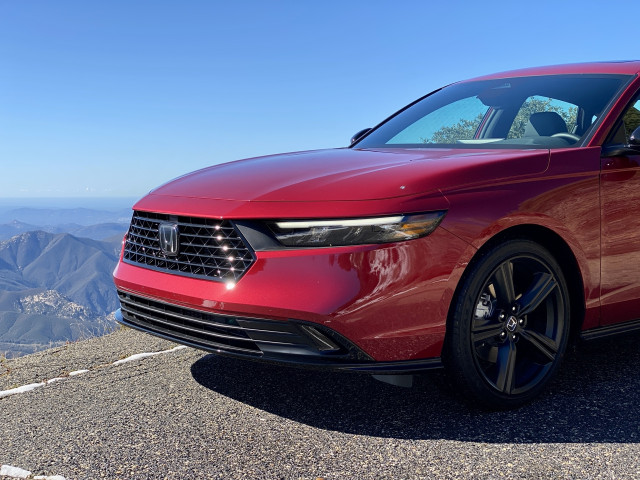
How does the Accord drive?
Quickness is not the forte of the Accord, but the rigid body makes up for it with balanced handling despite being front-wheel drive only. The base 1.5-liter turbo-4 makes 192 hp and 192 lb-ft, and it’s bound to a CVT that mostly operates in the background. Light but direct steering remains the Accord’s strength. The engine lacks the guts of the Camry, but the handling and steering feel are better.
What are the hybrid differences in the Camry and Accord?
The Accord’s two-motor hybrid system works with the 2.0-liter inline-4 to make 204 hp and 247 lb-ft of torque. At the start, it takes a beat for the power to come on when called, but the balance between the engine and motors is quiet, seamless, and seemingly effortless. Like an EV, paddle shifters enable six levels of regenerative braking with a near one-pedal driving mode, but it still has the creep of gas cars in gear.
The Camry Hybrid shows its age alongside the Accord. A small lithium-ion battery powers a 118-hp motor that supplements the 2.5-liter inline-4 for a total output of 208 hp. The planetary hybrid transmission balances power demands and allows for some low-range electric driving, but the system is louder and more noticeable than the Accord.
Advantage: For the hybrid, it’s the Accord; for combustion only, the Camry all the way.
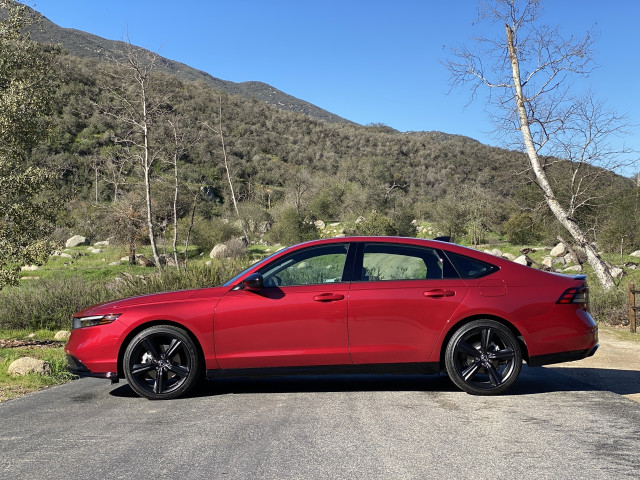
2023 Honda Accord Hybrid
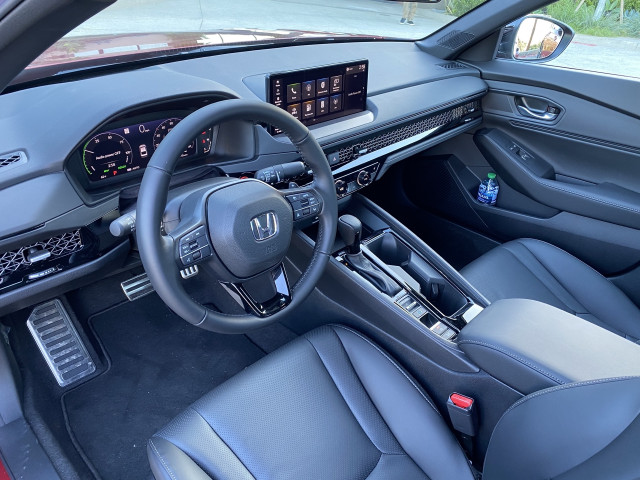
2023 Honda Accord Hybrid
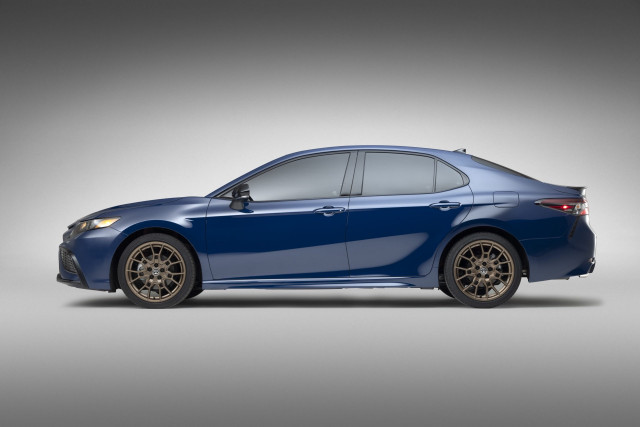
2023 Toyota Camry
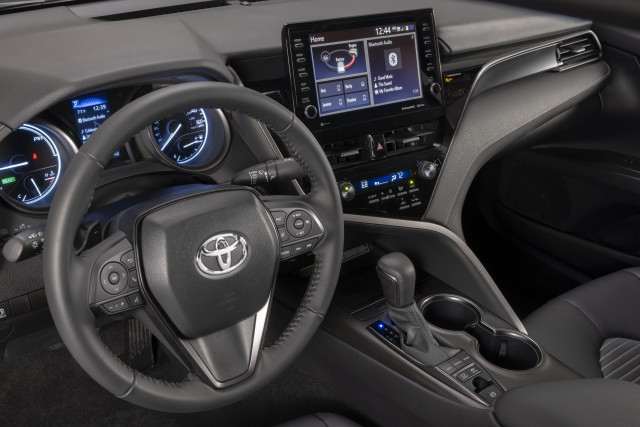
2023 Toyota Camry
Toyota Camry vs. Honda Accord fuel economy
Toyota Camry Hybrid LE: 51 mpg city, 53 highway, 52 combined
Honda Accord Hybrid EX-L: 51/44/48 mpg with 17-inch wheels
Toyota Camry inline-4: LE and SE get 28/39/32 mpg
Honda Accord turbo-4: 29/37/32 mpg
Is the Honda Accord good on gas?
Yes. With a small turbo-4 and a continuously variable transmission, it has an EPA rating of 29 mpg city, 37 highway, 32 combined. That’s roughly the same as the Toyota Camry 4-cylinder, but the Accord is more efficient around town and the Camry better on the highway.
The wheel size makes a difference on the Accord Hybrid, as it does on every vehicle. The EX-L rides on 17-inch wheels with a smaller contact patch that results in a 51/44/48-mpg rating. The Sport, Sport L, and Touring models roll on fatter 19-inch wheels that look cool but drag efficiency down to 46/41/44 mpg.
Is the Toyota Camry good on gas?
The Camry goes that extra mile across the board. The Camry Hybrid outpaces the Accord on base LE versions (51/53/52 mpg) as well as SE, XLE, and XSE models (44/47/46 mpg).
The 2.5-liter matches the Accord’s turbo-4, but the Camry XLE and XSE increase the wheel size from 17 to 18 inches, and add more content so they’re heavier. The EPA rating dips 1 mpg to 27/38/31 mpg. All-wheel-drive versions take a 3 mpg drop, down to 25/34/29 mpg for the Camry LE and SE, or 25/34/28 mpg for XLE and XSE models.
The endangered V-6 will make you happier behind the wheel than at the pump. It rates at 22/32/26 mpg, and TRD models are 22/31/25 mpg.
Advantage: The Camry’s better, measure by measure.
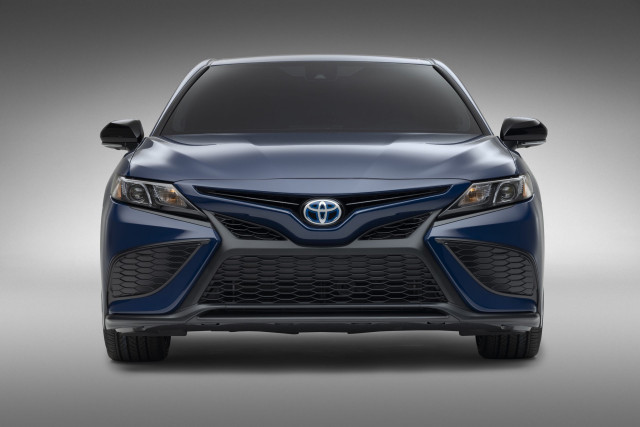
Camry vs. Accord size, roominess, and comfort
The Accord is bigger and roomier
The Accord has 16.7 cubic feet of trunk space versus 15.1 in the Camry
The Accord has 40.8 inches of rear legroom versus 38.0 inches in the Camry
Hybrid versions of both offer the same cargo room as gas models
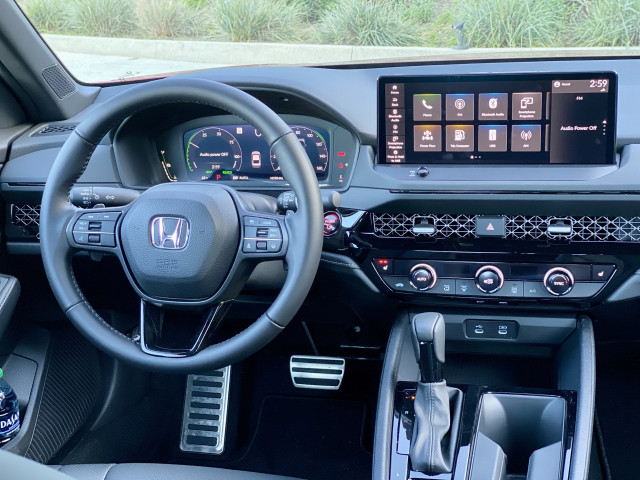
2023 Honda Accord Hybrid
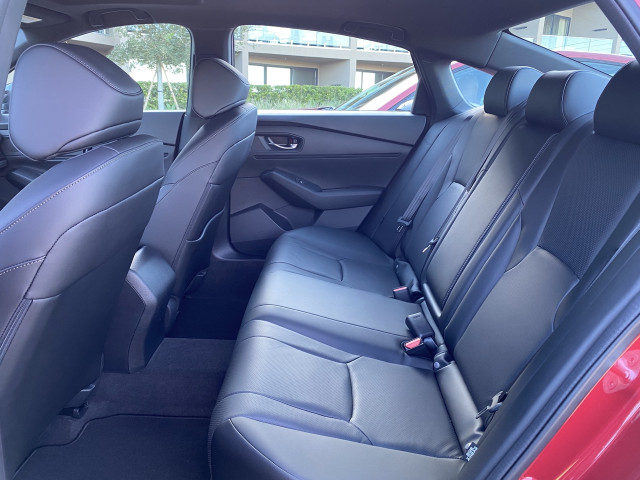
2023 Honda Accord Hybrid
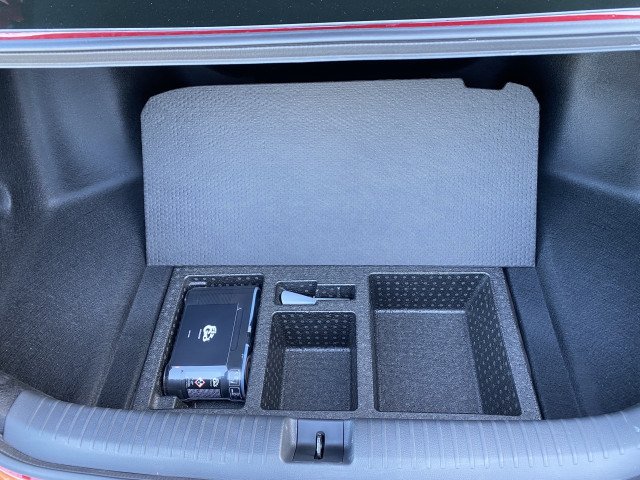
2023 Honda Accord Hybrid
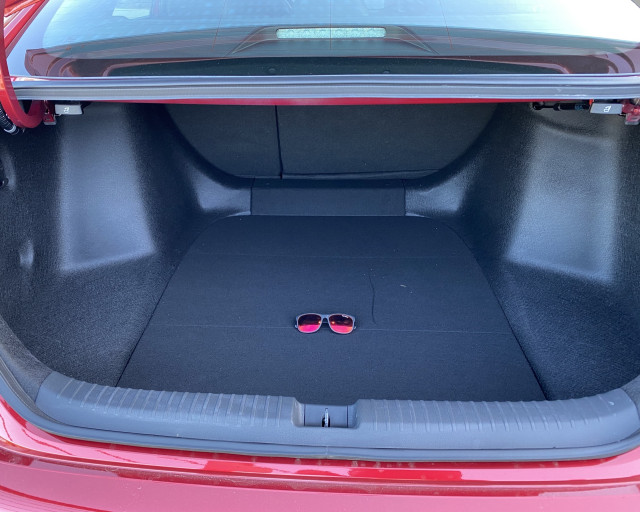
2023 Honda Accord Hybrid
How roomy is the Honda Accord?
The Accord is 3.0 inches longer than the Camry, but the 111.4-inch wheelbase is nearly the same. Yet, as in its other crossovers and cars, Honda excels at optimizing the interior space, from a recessed floor in the roomy trunk to deep door pockets and bins.
The base LX has cloth seats with manual adjustments, but most front seats sport heaters and power adjustments. Honda upgraded the seats with good cushion and support, and we prefer the narrower console to that in the Camry. Rear passengers get treated to a crossover-like legroom of 40.8 inches and good headroom, but in either car, the middle seat favors younger people at best, and at the expense of those in the outboard seats.
The 60/40-split rear seats fold down to expand trunk space, and both the Accord and Camry don’t sacrifice any trunk space to hybrid battery packs. The Accord’s is roomier, however, measuring 16.7 cubic feet versus 15.1 cubes in the Camry.
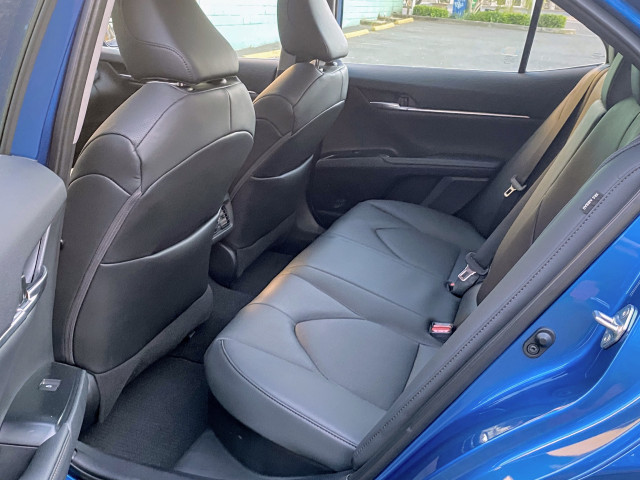
2020 Toyota Camry Hybrid XLE – Driven – Portland OR, April 2020

2023 Toyota Camry

2023 Toyota Camry
How roomy is the Toyota Camry?
The Camry measures up to the Accord by most metrics but doesn’t feel as roomy. The front passenger seat is walled off from the console and pinches some legroom. The driver seat has power adjustments with lumbar support, and both front seats are supportive, however.
The rear seats offer up 38.0 inches of rear legroom but the high window line and low roofline cause rear passengers to duck in more than the Accord and feel slightly more cramped.
Advantage: The Accord.
Camry vs. Accord safety
The NHTSA gives the Camry five stars
The IIHS rates the Accord as a Top Safety Pick+
Automatic emergency braking with pedestrian detection, active lane control, adaptive cruise control standard on both
How safe is the Honda Accord?
The IIHS gave it a Top Safety Pick+ designation, which is considered to be the highest safety rating in the industry, especially with more rigorous criteria introduced for 2023. have not tested it at the time of publication. We’ll update this accordingly.
Honda equips every Accord with automatic emergency braking, blind-spot monitors, active lane control, adaptive cruise control, traffic jam assist, automatic high beam headlights, and a rear seat reminder. That’s an impressive suite of driver-assist tech designed to avoid or mitigate crashes.
How safe is the Toyota Camry?
The Camry has many of the same standard features, except they charge extra for blind-spot monitors. The Camry gets a top five-star designation from the NHTSA and is a perennial Top Safety Pick+ recipient from the IIHS. A new side impact test to reflect the reality of more SUVs and trucks on roadways, however, resulted in a “Poor” rating from the IIHS.
Advantage: The Camry, until Accord testing is complete.
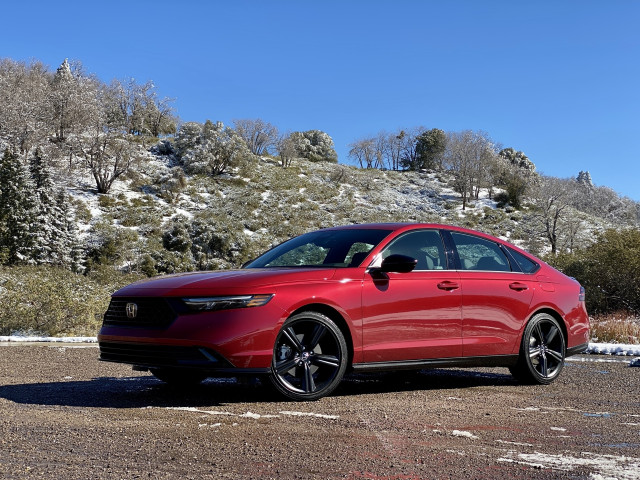
2023 Honda Accord Hybrid
Which is better: Honda Accord or Toyota Camry?
Buyers have more choice with the Camry. But the Accord is roomier and marginally better equipped. It earns a TCC Rating of 7.0 out of 10. The Camry performs better in both acceleration and efficiency, however. It earns a TCC Rating of 6.7 out of 10. Ultimately, the big difference between the two is because our Green rating favors the volume models of both, which is the hybrid in the Accord’s case, and the 2.5-liter inline-4 in the Camry’s case. (Read more about how we rate cars.) The Accord feels fresher, roomier, and a bit more refined. The Camry gives you more options and greater hybrid efficiency. Newness favors the Accord.

